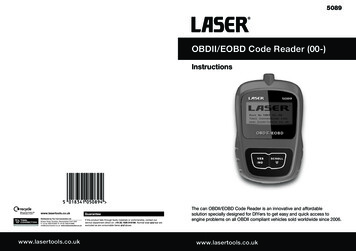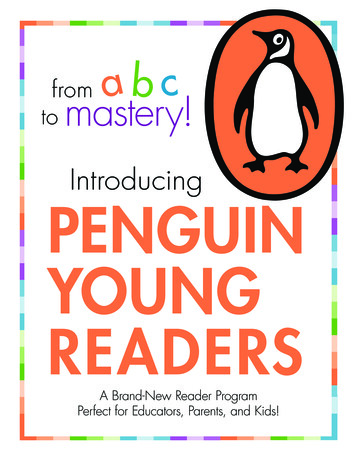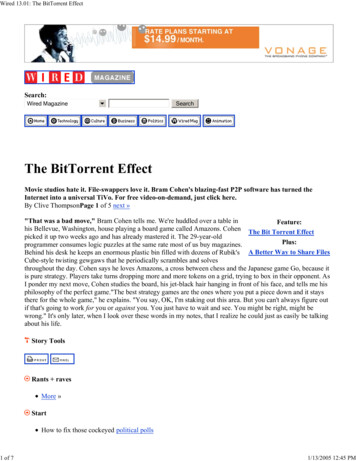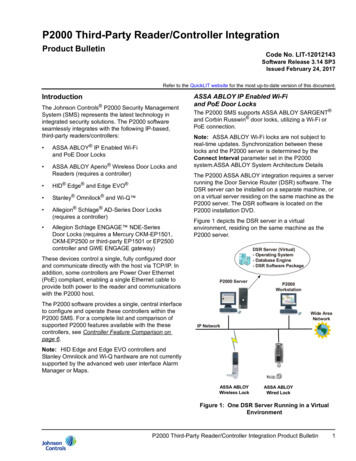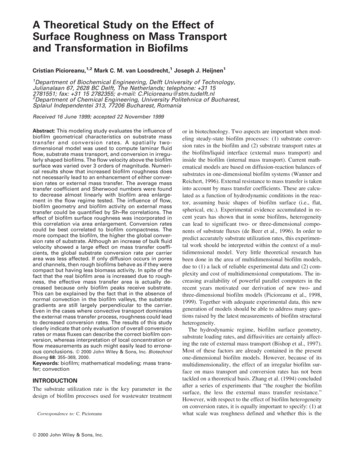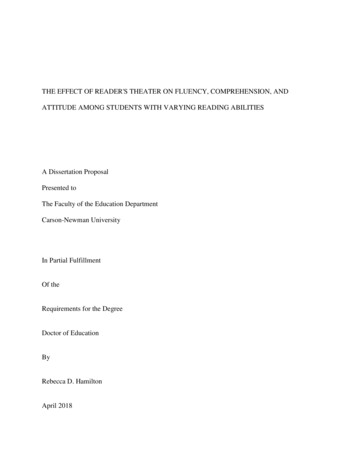
Transcription
THE EFFECT OF READER'S THEATER ON FLUENCY, COMPREHENSION, ANDATTITUDE AMONG STUDENTS WITH VARYING READING ABILITIESA Dissertation ProposalPresented toThe Faculty of the Education DepartmentCarson-Newman UniversityIn Partial FulfillmentOf theRequirements for the DegreeDoctor of EducationByRebecca D. HamiltonApril 2018
Copyright 2018 by Rebecca Dawn HamiltonAll rights reserved.ii
AbstractA multitude of research has proven that repeated reading is an effective strategy to improvefluency in struggling readers. Students who struggle to read will inevitably fall behind in fluencyand comprehension. As they have more and more negative experiences with reading, theirreading attitude will decline. Building on previous research, this study investigated theeffectiveness of repeated reading, through Reader’s Theater, among readers with varying readingabilities. Reader’s Theater is an avenue to improve fluency, comprehension, and reading attitude.It is a method of repeated readings in which students read a short passage multiple times andthen perform for an audience. The theoretical foundation of this study is the Theory ofAutomaticity. This theory states that if all cognitive processes are utilized for decoding a word,there will be none left for comprehension. This quasi-experimental study investigated the impactof Reader’s Theater on fluency, comprehension, and reading attitude. There were 13 first gradeparticipants in both the control group and treatment group. Pre and post-test were given to bothgroups. The means of differences between the treatment and control group were analyzed usingan independent t-test and Mann-Whitney U. The results showed no significant difference in theindividual components of fluency (expression/volume, phrasing, smoothness, and rate).However, when the first three components of fluency, which measured prosody, were groupedtogether and analyzed there was a significant difference between the treatment and controlgroups. The difference in the means of comprehension and reading attitude were not significantbetween the treatment and control group.iii
AcknowledgementsI would say thank you to Dr. Price, but that doesn’t express how grateful I am for hersupport throughout this process. Her determination for her students to succeed was unrelenting,and a vital part of what kept me going to the end.A big thank you also goes out to my other committee members. Thank you for the roleyou both played in me completing my dissertation. Your support and encouragement weregratefully appreciated. Mr. Peoples and Dr. Taylor thank you both for making statistics not soscary for me. Dr. Whitehead, thank you for the emails encouraging me along the way and thehelp with the page numbers!I would also like to thank the administration, faculty, students, and parents of a certainelementary school. To my students, thank you for participating in this study. I have learned somuch from each of you. You have made me a better teacher. Finally, a big thank you goes outto my teaching assistant, Teresa Brown. She tirelessly covered for me and helped me out inmore ways than I can mention.iv
DedicationAbove all, I dedicate this work to my Lord and Savior. I know without a doubt he madeall this possible and gave me the strength to keep going. To my husband, Jason, thanks for yoursupport and not giving up on me. To my children, Bailey, Callie, and Eli. I look forward to nothaving to say, “I can’t do that right now, I’m working on my paper.”To my mom and dad, I love you both! Thanks for your continuous prayers and ongoingsupport. You guys made me the person I am today.v
Table of ContentsAbstract.iiiAcknowledgement .ivDedication.vList of Tables .ivList of Figures . xChapter 1. Introduction .1Background and Introduction of Study 1Statement of the Problem . .2Purpose of the Study 3Significance of the Study .3Theoretical Framework 5Research Questions .8Null Hypothesis .8Delimitations 9Limitations .9vi
Assumptions .10Definition of Terms . .10Organization of the Document . 12Chapter 2: Literature Review 13History of Reading .13Current State of Reading 15Title 1 Schools Reading Achievement .16Attitude Toward Reading .17Five Pillars of Reading .18Relationship Between Fluency and Comprehension .29Repeated Reading . 31Reader's Theater . . .35Summary . .37Chapter 3: MethodologyIntroduction 39Research Question .39vii
Population/Sample .39Description of the Instruments .40Research Procedures .42Data Analysis .43List of References .45viii
List of TablesTable 4.1 44Table 4.2 46Table 4.3 49Table 4.4 52Table 4.5 55Table 4.6 59ix
List of FiguresFigure 4.1 .45Figure 4.2 .46Figure 4.3 . .48Figure 4.4 . . .49Figure 4.5 . 51Figure 4.6 . .52Figure 4.7 . 54Figure 4.8 . 55Figure 4.9 . 57Figure 4.10 .58x
xi
1Chapter 1: IntroductionSometime throughout their career, most teachers have fastidiously listened to the suddenstart and stop of a student reading. This type of reading is characterized as being disfluentbecause the reader reads slowly, in an uneven manner, and without expression (Allington, 1990).Another characteristic of disfluent readers is that they often extricate themselves from readinginstruction because of frustration (Rasinski, 2003b).To prevent this sudden start and stop type of reading, which only leads to frustration,fluency should be implemented into the reading curriculum (Hudson, Lane, & Pullen, 2005).Although, there are numerous contributing variables that influence a student’s reading progress,reading fluency is a rudimentary component to being a good reader (Rasinski, 2003b). Poorreaders often lack fluency. Fluency levels not only distinguish good readers from poor readersbut, are also an undeviating indicator of comprehension (Hudson, Lane, & Pullen, 2005).Therefore, students cannot achieve comprehension, which is the ultimate goal of reading, whentheir reading is excessively slow (Rasinski, 2000). Students who do not accurately decode havelittle understanding of the author’s purpose, which will likely lead to the readers’ misconceptionof the text (Kulich, 2009). Reviews of fluency instruction have deducted that fluency instructionadvantageously impacts fluency achievement, as well as general reading performance (Kuhn &Stahl, 2003; Rasinski & Hoffman, 2003).The most compelling rationale to teach fluency is because of the relationship betweenfluency and comprehension (Hudson, Lane, & Pullen, 2005). Kulich (2009) delineated thispartnership as one “nourishing” the other. The relationship between fluency and comprehensionhas also been described as advantageous (Pikulski & Chard, 2005). Strecker, Roser, & Martinez
2(1998) noted that fluency is integral to comprehension and a vital element to a productivereading program. Research in relation to assessment has noted the relationship betweenmeasures of fluency as being highly associated with measures of comprehension (Rasinski,2004a). Teachers must make instructional efforts to help students become more fluent(Allington, 1983; Torgesen, 1998). The National Research Council (Snow, Burns, & Griffin,1998) recommended that efficacious fluency components be reinforced in the classroom whendisfluent reading is evident.Statement of ProblemFluency must be explicitly taught and modeled (Rasinski, 2004a). However, this has notalways been the case. “Fluency is often taught as a separate area of the reading curriculum,distinct and apart from authentic reading students do during guided reading or readingworkshop” (Rasinski, 2012, p. 517). Similarly, Ming and Dukes (2008) noted that fluency is notintegrated into reading curriculum. It is not regarded as vital to veritable reading (Rasinski,2012).For two consecutive years (2009, 2010) a survey of reading experts deduced that fluencyshould not be considered a noteworthy subject (Cassidy & Cassidy, 2010; Cassidy, Ortlieb, &Shettel, 2011). Prior to this survey, Allington (1983) ascertained that fluency was a forgottencomponent of the reading curriculum. Similarly, in 1991, (Rasinski & Zutell) reported thatteachers and reading experts gave minimum attention to directly or even indirectly teachingfluency as a component of their reading curriculum. Fluency has also been described as the“forgotten stepchild” of reading instruction (Rasinski, Homan, & Biggs, 2009).
3In fact, the essentialness of fluency instruction has only surfaced a little more than adecade ago (Rasinski, 2003a; Zutell & Rasinski, 1991). This is quite astonishing becausefluency is one of the five pillars of reading (National Reading Panel, 2000). It is a vitalcomponent of a strong reading program. Further complicating matters, is the notion that fluencyhas often been taught in the classroom as speed reading (Stayter & Allington, 1991; Rasinski,2012). Teachers rely on one-minute timed passages to determine if a child is fluent. With thisbeing the case in so many classrooms, students are not reading for meaning and, therefore,students are becoming speed readers with no regard to comprehension (Rasinski, 2012). Deeney(2010) cautioned that using one-minute timed passages as the sole measurement of fluency couldlead to a misinterpreting of a student’s fluency. Other research by Dowhower (1987) suggestedthat focusing only on rate and accuracy gives students the impression that reading is only aboutsaying the words correctly and quickly.Purpose of StudyThe purpose of the present study is to determine the level of effectiveness that Reader’sTheater has on first grade students with varying levels of reading abilities. The present studyalso sought to examine how the attitudes of first grade students with varying levels of readingabilities were affected by Reader’s Theater.Significance of StudyThe significance of this study is that it sought to determine how Reader’s Theater wouldaffect the reading abilities of students at all levels of reading. Past studies have proven itseffectiveness with struggling readers. For example, Ming and Dukes (2008) noted that studentswho had trouble reading can capitalize from a well-rounded, researched-based reading program
4that explicitly teaches fluency. Rasinski (2014) described fluency instruction as having anoutstanding benefit for students, especially those who struggle. Hudson, Lane, and Pullen (2005)stated that fluency is an essential part of a thriving reading program and is especially beneficialto students who struggle. Fluency can be a vital ingredient for struggling readers (Rasinski,Homan, & Biggs 2008).Although numerous studies have proven the effectiveness of Reader’s Theater withstruggling students, minimal research has investigated how effective Reader’s Theater is withstudents at varying reading levels. A study that synthesized 24 research studies regardingfluency interventions suggested the need for more research regarding repeated readings withlearners of all reading levels (Chard, Vaughn, & Tyler, 2002). Rasinski and Hoffman (2003)described repeated readings as beneficial to all learners, but the levels of learning were notcategorized to see how effective repeated reading was at each level. This sentiment is echoed invarious other research studies concerning repeated reading through Reader’s Theater (Martinez,Roser, and Strecker,1999; Rasinski, 2006; Rasinski, 2012). A plethora of studies have concludedthat repeated readings, which can be integrated through Reader's Theater, are beneficial tostudents, but few have categorized the participants into reading levels and investigated just howeffective repeated reading is at each reading level (above average, average, below average).Therefore, this study sought to investigate how repeated readings, through the use of Reader’sTheater, affected students with varying reading levels.
5Theoretical BackgroundTheory of AutomaticityThis study was based on the Theory of Automaticity developed by LaBerge and Samuels (1974).The Theory of Automaticity has been utilized for more than 30 years to help explain the intricateendeavor of reading (Schrauben, 2010). It has dominated over the years because of its ability toaccount for the development of fluency. Specifically, The Theory of Automaticity stated thatrepeated reading fosters fluency development. Samuels (1979) used the analogy of comparing areader to an athlete. He stated that a reader can improve his or her reading by repeated readingsjust like a basketball player can improve his or her basketball ability by practicing basketballdrills. Reiterating this fact with a different analogy, Samuels, Ediger, & Patridge (2005)described the vocalizations of a new driver as they talk themselves through the process ofdriving, and compared them to a reader sounding out words. Eventually, there is no need tosound out the words because the word recognition phase has become automatic for the readerjust as the process of driving has become automatic to the driver. When the driver internalizesthe process, he or she can then do more than just driving, such as talk to another person in thecar. Just as when word recognition becomes automatic for the reader, he or she can thencomprehend the text.This change from non-automatic to automatic word recognition, through repeatedreadings, is what allows readers to have enough mental capacity left for comprehension(Schraubem, 2010). LaBerge and Samuels (1974) argued that people could not focus on morethan one thing at a time. A reader cannot focus all of his or her attention on decoding andcomprehension simultaneously. In this case, the process of reading would be grueling becausethe reader would not have enough mental capacity to give the needed attention to both decoding
6and comprehension at the same time. In fact, this is the very foundation of the Theory ofAutomaticity. If all mental capacity is used to decode words, no mental capacities will remain toensure the text is being understood (LaBerge and Samuels, 1974).There are three varied stages that coincide with fluency. The first stage is called nonaccurate stage. At this stage, recognizing words is a hindrance to the reader. The next stage iscalled the inaccurate stage. In this stage, readers decode slowly and carefully with minusculeattention to prosody and usually no attention to comprehension. The last stage is the automaticstage. In this stage, readers read with appropriate accuracy, prosody, and rate (Samuels,1997).This allows comprehension to be attained. The accuracy level of performance necessitatesattention to processing; at the automatic level there is no need for attention to be required forprocessing (LaBerge & Samuels, 1974). "Throughout these stages information travels fromvisual, phonological, and episodic memory until it finally reaches semantic memory”(Schrauben, 2010, p. 84).Moreover, LaBerge and Samuel’s Theory of Automaticity explains how readers attainautomatic word recognition through repeated readings of the same text (Schrauben, 2010). Asreaders are exposed to the same text repeatedly, they will likely be able to recognize the wordswith progressively more accuracy and automaticity. This progressive building of accuracy andautomaticity is what enables the reader to focus attention on comprehension instead of decoding;resulting in gaining meaning from the text (Samuels, 1974).This research study was conducted using Readers’ Theater, a modified repeated readingtechnique in which students repeatedly read and practiced a single text with the purpose of
7increasing fluency and comprehension. The impact of this technique on word recognition andcomprehension over time were noted. Samuels’ Theory (1979) provided a framework for thisstudy. Samuel theorized that attention to decoding took time away from comprehension.According to automaticity theory, readers are involved in two important jobs at once. Thosetasks are decoding the words and understanding the text. Due to the modest measure of attentionaccessible to any reader, attention that is given to the decoding of words cannot also be used forcomprehending the text. Readers who need a vast amount of cognitive effort for decoding maydisregard meaning because of their insufficiency of focusing on understanding the text (Mraz etal., 2013).Vygotsky's Social Learning TheoryThe second theory that supported this study was Vygotsky's Social Learning Theory.Vygotsky (1978) emphasized the importance of social interaction in cognitive development;especially the learning that takes places through interaction with a more knowledgeable person.He theorized that social learning came before cognitive development. Children internalizeinformation from social interactions and learn from those interactions. These interactions from amore knowledgeable other will impact what they know. In most cases the more knowledgeableother is an adult, but it does not necessarily have to be.Along with the principle of the more knowledgeable other, Vygotsky (1978) coined thephrase "zone of proximal development." The zone of proximal development is described as thegap between what a child can successfully achieve alone versus what he or she can achieve withsupport (Young, Moore, & Rasinski, 2015). Vygotsky ascertained that the zone of proximaldevelopment is a better predictor of intellectual development than the present level ofdevelopment (Guseva & Solomonvich, 2017). Teachers should instruct students within their
8zone of proximal development for optimal development. This type of teaching will allowchildren to develop mental processes that would otherwise not be developed.Closely linked to the zone of proximal development is the concept of scaffolding(Fernández, Wegerif, Mercer, & Drummond, 2015). Scaffolding was described as short termintellectual support that moves the learner toward a superior rank of learning (Wass & Golding,2014). Scaffolding allows the students, over time, to complete the task by themselves, buteducators need to be careful not to give students too much help. Instead, educators should onlygive enough support so that students can manage the task but not so much that no learning takesplace. If rote learning is the focus of the classroom, then the students will not be challengedbecause they will not be working in their Zone of Proximal Development. Conversely, tasks thatare too challenging will not allow the students to eventually complete them on their own, evenwith scaffolding.Research QuestionsThis research investigated the following questions to determine the effectiveness ofReaders Theater in targeting and improving the reading skills and attitudes of the participants inthe study:1. What effect does participation in Reader’s Theater have on reading fluency amongstudents at varying reading levels?2. What effect does participation in Reader’s Theater have on reading comprehension amongstudents at varying reading levels?3. What is the impact of Reader’s Theater on the attitudes toward reading among students at
9varying reading levels?Null Hypotheses1. Reader’s Theater will not have a significant effect on students’ fluency among students atvarying reading levels2. Reader’s Theater will not have a significant effect on students’ comprehension amongstudents at varying reading levels.3. Reader’s Theater will not have a significant effect on students’ attitudes toward readingamong students at varying reading levels.Limitations/DelimitationsThe limitations of this study included the following. The first limitation was conveniencesampling. Convenience sampling is simply choosing people for the study because of easy access(Dudovoskiy, 2017). The participants were two out of three first grade classes. One of theclasses received the treatment of Reader’s Theater, while the control group continued with theregular reading program. The control group was selected because they had similar readingabilities to the treatment group. The text chosen for Reader’s Theater were nursery rhymes due tostudents' reading levels at the beginning of first grade.This study took place in an elementary school in southeast Tennessee with 30 first gradeparticipants (15 in the control group and 15 in the treatment group), which may limit thegeneralizability of the results. Validity concerns of the population warranted the findings to belimited to first grade students in Elementary School Z. Random assignment was not used becauseof the possible disruptions it may have caused to the educational environment. Matching of
10students' academic levels was utilized to academically align the control group with the treatmentgroup. Normally, in a school setting, quasi-experimental designs are seen as efficacious optionsto experimental designs due to the make-up of the educational environment and possiblejeopardy to students by using experimental research (Ary, Jacobs, Razavieh, & Sorenson, 2009).Using rating scales that have established reliability and validity helped to strengthen thestudy because reliability and validity have been established and the rating scales have been usedsuccessfully over the years concerning the same subject that this study investigated. Aligningacademic levels of the treatment and control groups strengthened the study. Another strength ofthis study was that the evaluation of reading attitudes.AssumptionsOne assumption is that the Theory of Automaticity explains how information that is takenin visually is processed through a sequence of phases and eventually leads the reader tocomprehend the text. Another assumption is that the participants will honestly rate themselveson the Reading Attitude Survey. Still yet, another assumption is that participants have a sincereinterest in participating in the study and are not doing it for reciprocity reasons. Anotherassumption is that the students will perform to the best of their ability on all pre and post-tests.Related to the prior assumption, it was assumed that the improvement in oral reading during therepeated reading intervention transferred to the silent reading used during the readingcomprehension posttest.Definitions of Key Terms
11Reader’s Theater- Reader's Theater is a “performance activity in which group of studentsperform a script. no costumes, props, movement, scenery, or memorization of lines” (Padak &Rasinski, 2004, p. 125).Fluency - the ability to read text quickly, smoothly, effortlessly, with prosody, andautomatically with little attention to sub skill tasks such as decoding (Rasinski, 2003).Accuracy-refers to the ability to recognize or decode words correctly (Hudson, Lane, & Pullen,2005).Automaticity – fast, accurate, oral reading of text which read at a rate similar to the rateof speaking with effortless identification of words (Samuels, 1979).Curriculum-based Measurement (CBM) - techniques educators use to find out how pupils aredeveloping in fundamental academic areas such as math, reading, writing, and spelling (McLane,n. d.).Repeated reading – reading a meaningful passage of connected text several times untilidentified level of fluency is attained (Samuels, 1979).Reading comprehension-the ability to understand what is being read (Cooper, 2000).Prosody- ability to read with expression (Dowhower, 1991).Reading attitude- how students feel toward recreational and academic reading asmeasured by the Elementary Reading Attitude Survey (McKenna & Kear, 1990).
12Title I: Title I is a federal assistance program that allocates funds to school districts with highpercentages of students who are economically disadvantaged (U.S. Department of Education,2002, p. 13).Title I schools: Schools that have a high population of students determined to be economicallydisadvantaged and that receive funding based on this status. (USDOE, 2002, p. 13).Organization of DocumentThe study is organized in the following manner. Chapter 2 contains a review of therelevant literature pertaining to reading achievement. First, the history of reading is discussedfollowed by the current state of reading instruction. Next, a review of reading in Title I schoolsis discussed followed by a look at student attitudes toward reading. Each of the five pillars ofreading are presented with a more in-depth look at comprehension and fluency. Then,relationship between comprehension and fluency is examined. Chapter 2 ends with an in-depthdiscussion of repeated reading and Reader's Theater followed by a summary.
13Chapter 2: Review of LiteratureHistory of ReadingReading instruction, like most things in the world of education, has changed over theyears. Instructional strategies have been adjusted frequently (National Reading Panel, 2000).Teachers need to be acquainted with prior reading practices and the validity of each of them.While some practices are still valid, others are not. By familiarizing themselves with whatreading practices have been used in the past, educators are able to avoid those that do not providecompetent instruction to students (McCormick & Zutell, 2015).In the 1700s education moved from homes into schools (Rehyner, 2008). In the 1800s,phonics became known as the best practice in reading (McCormick & Zutell, 2015). In the1920s, strategies evolved from phonics and moved to the whole word approach. The wholeword approach is described as a top to bottom approach. Teachers immerse their students in aprint-rich environment, exposing them to books with many of the same words. Repeatedexposure to the words allows readers to learn them. Conversely, phonics is a bottom to topapproach. It is based on being able to break apart words into sounds and then blend those soundstogether to make a word (Rehyner, 2008).In the decade of the 1930s, the language experience approach was introduced. Thisapproach involves combining all four aspects of literacy; reading, writing, speaking, andlistening. A language experience approach lesson is generated around an experience that theclass has completed together. This is call a shared experience. Examples of shared experiencescan be a field trip or other experience that the class has accomplished. The shared experience isthen used to create a text. The students give details about the experience as the teacher records
14them. The text is read and edited by the class with support from the teacher. The story is thenread in a variety of ways including echo reading, choral reading, or partner reading. Anextension activity is usually the final part of the language experience approach. An extensionactivity can include drawing illustrations to add to the story, answering comprehension questionsrelated to the story, or reading other books related to the topic of the shared experience (Brace, n.d.).In the 1940s, the Language Experience Approach (LEA) was replaced with an emphasison both silent reading and reading aloud (McCormick & Zutell, 2015). By the end of the 1940sLEA returned. Phonics was the main instructional reading strategy of the 1950s. The readinginstructional strategy of the 1960's focused on teaching to all modalities. These modalities arevisual, kinesthetic, and auditory. During the 1970s, LEA became prominent again. Theimportance of improving comprehension emerged during the 1980s. Whole language returned inthe latter part of the 1980s and the early 1990s (Cassidy, Valadez, & Garrett, 2010). “Balancedliteracy instruction” became prominent in the latter part of the 1990s (McCormick & Zutell,2015). One such program that showcases a balanced literacy program is called Four Blocks.The components of Four Blocks consist of a self-selected reading block, working with wordsblock, guided reading block, and a writing block (Campbell, 1999). At the turn of the 21stcentury, emphasis was placed on reading programs that are researched-based along with anemphasis on early intervention. From 2010 to the present, more emphasis has been placed onearly intervention through Response to Intervention programs (RTI) (McCormick & Zutell,2015). In contrast, a more recent survey of reading instructional practices, by Cassidy, Garcia,and Ortlieb, (2015) noted that early intervention, intervention in grades K-3, is no longer ofinterest. This same survey reported that close reading, text complexity, high stakes assessment,
15and Common Core Standards were topics of interest in 2015-2016. The topics of high interest
A multitude of research has proven that repeated reading is an effective strategy to improve fluency in struggling readers. Students who struggle to read will inevitably fall behind in fluency . cautioned that using one-minute timed passages as the sole measurement of fluency could le

